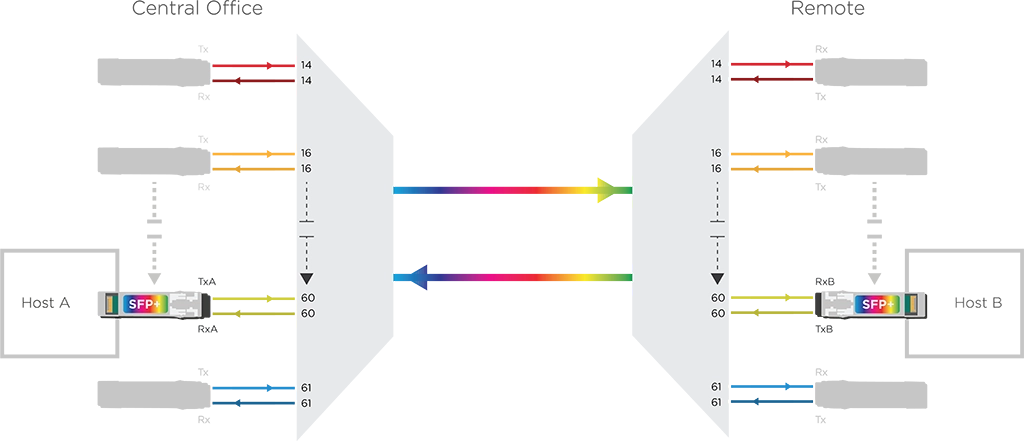What is DWDM and Why Should You Care?
Imagine a couple of small trucks moving along a country road in opposite directions, carrying goods between factories and consumers. As the population grows and demand increases, the trucks grow in number, and diversity of goods and traffic increases. City planners must start adding lanes until, eventually the tiny country road has become a large multi-lane highway with 18-wheelers moving vast volumes of different types of merchandise every day. A similar rapid expansion in ‘cargo’ has happened in telecommunications.
The telecommunications industry and service providers, in particular, have faced a dramatic and very rapid increase in the volume and type of data their systems must handle. Networks built initially to transmit soundwaves as electrical signals from one phone to another were now faced with managing data and video in real-time from many devices. Within approximately 30 years, we have moved from the introduction of the Internet and the creation of the Worldwide Web to the rollout of 5G wireless technology and the Internet-of-Things (IoT), through which virtually all devices can theoretically be interconnected.
Handling this exponentially increasing data traffic has required massive contributions from fiber optics and optical communications systems. In these systems, laser light carries much higher data transmission rates over greater distances than electrical signals. To encode the data into light, transmit it, and decode it back into electrical signals upon receipt, optical communication systems rely on optical transceivers. Dense Wavelength Division Multiplexing (DWDM) is a transceiver technology developed around 20 years ago that dramatically increases the amount of data transmitted over existing fiber networks. Data from various signals are separated, encoded on different wavelengths, and put together (multiplexed) in a single optical fiber.
The wavelengths are separated again and reconverted into the original digital signals at the receiving end. In other words, DWDM allows different data streams to be sent simultaneously over a single optical fiber without requiring new cables to be laid. In a way, it’s like adding more lanes to the information highway without having to build new roads!

The tremendous expansion in data volume afforded with DWDM can be seen compared to other optical methods. A standard transceiver, often called a grey transceiver, is a single-channel device – each fiber has a single laser source. You can transmit 10 Gbps with grey optics. Coarse Wavelength Division Multiplexing (CWDM) has multiple channels, although far fewer than possible with DWDM. For example, with a 4-channel CWDM, you can transmit 40 Gbps. DWDM can accommodate up to 100 channels.
You can transmit 1 Tbps or one trillion bps at that capacity – 100 times more data than grey optics and 25 times more than CWDM. While the volume of data transmitted with DWDM is impressive, demand will continue to grow as we move toward IoT and 5G. Adding additional optical transceivers with different wavelengths to a fixed-wavelength DWDM system can significantly increase costs. Tunable DWDM transceivers allow you to control the wavelength (color) that the laser channel emits, adding flexibility and reducing cost. However, two obstacles prevented the broader deployment of DWDM technology.
First of all, installing and maintaining many new DWDM optical links was a time-consuming and costly process. Fortunately, the telecom industry developed a new weapon to face these challenges: self-tuning DWDM modules. Self-tuning DWDM modules minimize the network’s time-to-service by eliminating additional installation tasks such as manual tuning and record verification and reducing the potential for human error. They are host-agnostic and can plug into any third-party host equipment.
Furthermore, tunability standards allow modules from different vendors to communicate with each other, avoiding compatibility issues and simplifying upgrade choices. Self-tuning modules made the deployment and operation of DWDM links faster, simpler, and more affordable. The second issue had to do with size. DWDM modules were traditionally too large, so plugging them into a router required sacrificing roughly half of the expensive router faceplate capacity. Telecom operators could not accept such a trade-off. Advances in electronic and photonic integration overcame these trade-offs, miniaturizing coherent line card transponders into pluggable modules the size of a large USB stick.
Few companies worldwide supply DWDM technology with such compact sizes and self-tuning features. EFFECT Photonics is among them, and its tunable and cost-effective DWDM technologies will act as enablers of 5G and IoT, bringing the future to you today.
